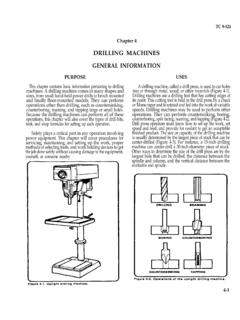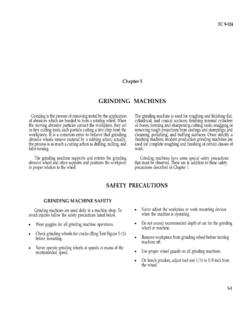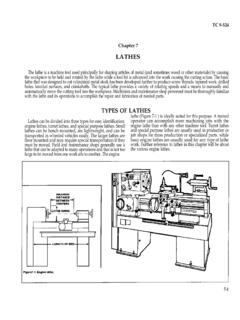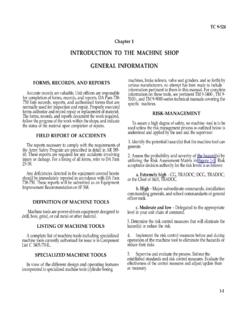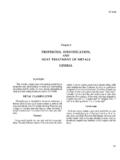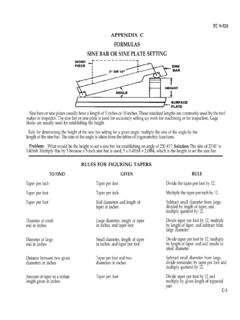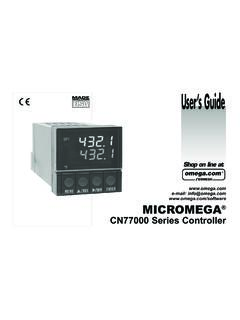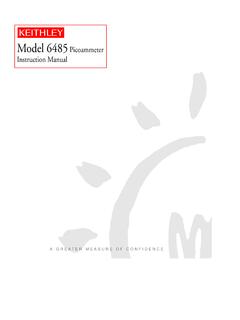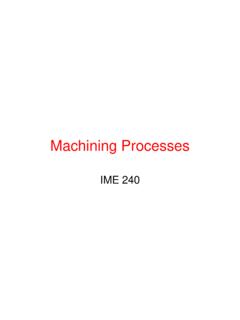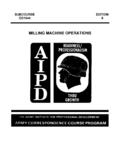Transcription of MILLING OPERATIONS TYPES OF MILLING MACHINES
1 TC 9-524 Chapter 8 MILLING OPERATIONSM illing is the process of machining flat, curved, orMilling MACHINES are basically classified as vertical orirregular surfaces by feeding the workpiece against a rotatinghorizontal. These MACHINES are also classified as knee -type,cutter containing a number of cutting edges. The millingram-type, manufacturing or bed type, and planer-type. Mostmachine consists basically of a motor driven spindle, whichmilling MACHINES have self-contained electric drive motors,mounts and revolves the MILLING cutter, and a reciprocatingcoolant systems, variable spindle speeds, and power-operatedadjustable worktable, which mounts and feeds the feedsTYPES OF MILLING MACHINESKNEE-TYPE MILLING MACHINEKnee-type MILLING MACHINES are characterized by a verticallyadjustable worktable resting on a saddle which is supportedby a knee .
2 The knee is a massive casting that rides verticallyon the MILLING machine column and can be clamped rigidly tothe column in a position where the MILLING head and millingmachine spindle are properly adjusted vertically for plain vertical MACHINES are characterized by a spindlelocated vertically, parallel to the column face, and mounted ina sliding head that can be fed up and down by hand or vertical MILLING MACHINES are designed so the entirehead can also swivel to permit working on angular surfaces,The turret and swivel head assembly is designed for makingprecision cuts and can be swung 360 on its base. Angularcuts to the horizontal plane may be made with precision bysetting the head at any required angle within a 180 plain horizontal MILLING machine s column contains thedrive motor and gearing and a fixed position horizontalmilling machine spindle.
3 An adjustable overhead armcontaining one or more arbor supports projects forward fromthe top of the column. The arm and arbor supports are used tostabilize long arbors. Supports can be moved along theoverhead arm to support the arbor where support is desireddepending on the position of the MILLING cutter or MILLING machine s knee rides up or down the columnon a rigid track. A heavy, vertical positioning screw beneathpast the MILLING cutter. The MILLING machine is excellent forforming flat surfaces, cutting dovetails and keyways, formingand fluting MILLING cutters and reamers, cutting gears, and soforth. Many special OPERATIONS can be performed with theattachments available for MILLING machine knee isused for raising and lowering. The saddle rests upon the kneeand supports the worktable.
4 The saddle moves in and out on adovetail to control cross feed of the worktable. The worktabletraverses to the right or left upon the saddle for feeding theworkpiece past the MILLING cutter. The table may be manuallycontrolled or power HORIZONTAL MILLINGMACHINEThe basic difference between a universal horizontal millingmachine and a plain horizontal MILLING machine is theaddition of a table swivel housing between the table and thesaddle of the universal machine. This permits the table toswing up to 45 in either direction for angular and helicalmilling OPERATIONS . The universal machine can be fitted withvarious attachments such as the indexing fixture, rotary table,slotting and rack cutting attachments, and various MILLING MACHINEThe ram-type MILLING machine is characterized by a spindlemounted to a movable housing on the column to permitpositioning the MILLING cutter forward or rearward in ahorizontal plane.
5 Two popular ram-type MILLING MACHINES arethe universal MILLING machine and the swivel cutter headram-type MILLING RAM-TYPE MILLINGMACHINEThe universal ram-type MILLING machine is similar to theuniversal horizontal MILLING machine, the difference being,as its name implies, the spindle is mounted on a ram ormovable 9-524 SWIVEL CUTTER HEAD RAM-TYPEMILLING MACHINEThe cutter head containing the MILLING machine spindle isattached to the ram. The cutter head can be swiveled from avertical spindle position to a horizontal spindle position orcan be fixed at any desired angular position between verticaland horizontal. The saddle and knee are hand driven forvertical and cross feed adjustment while the worktable can beeither hand or power driven at the operator s RULES FOR MILLING MACHINESM illing MACHINES require special safety precautions whilebeing used.
6 These are in addition to those safety precautionsdescribed in Chapter not make contact with the revolving a wooden pad or suitable cover over the tablesurface to protect it from possible the buddy system when moving heavy MILLING machine configurations are shown in 9-524Do not attempt to tighten arbor nuts using installing or removing MILLING cutters, always holdthem with a rag to prevent cutting your setting up work, install the cutter last to avoidbeing adjust the workpiece or work mounting deviceswhen the machine is should be removed from the workpiece with anappropriate rake and a Chip rake should be fabricated to the size of theT-slots (Figure 8-2).Shut the machine off before making any adjustments using cutting oil, prevent splashing by usingappropriate splash guards. Cutting oil on the floor cancause a slippery condition that could result in operatorinjuryTOOLS AND EQUIPMENTMILLING CUTTERSM illing Cutter NomenclatureClassification of MILLING CuttersFigure 8-3 shows two views of a common MILLING cutterMilling cutters are usually made of high-speed steel and arewith its parts and angles identified.
7 These parts and angles inavailable in a great variety of shapes and sizes for varioussome form are common to all cutter You should know the names of the most commonclassifications of cutters, their uses, and, in a general way, theThe pitch refers to the angular distance between like orsizes best suited to the work at 9-524 The pitch is determinedtooth face is the forwardforms the cutting the number of surface of the toothThethatThe cutting edge is the angle on each tooth that performsthe land is the narrow surface behind the cutting edge oneach rake angle is the angle formed between the face ofthe tooth and the centerline of the cutter. The rake angledefines the cutting edge and provides a path for chipsthat are cut from the primary clearance angle is the angle of the land ofeach tooth measured from a line tangent to the centerlineof the cutter at the cutting edge.
8 This angle prevents eachtooth from rubbing against the workpiece after it makesits angle defines the land of each tooth and providesadditional clearance for passage of cutting oil and hole diameter determines the size of the arbornecessary to mount the MILLING MILLING cutters that are more than 3/4 inch in widthare usually made with spiral or helical teeth. A plainspiral-tooth MILLING cutter produces a better and smootherfinish and requires less power to operate. A plain helical-tooth MILLING cutter is especially desirable when millingan uneven surface or one with holes in of TeethThe teeth of MILLING cutters may be made for right-hand orleft-hand rotation, and with either right-hand or left-hand8-4helix. Determine the hand of the cutter by looking at the faceof the cutter when mounted on the spindle.
9 A right-handcutter must rotate counterclockwise; a left-hand cutter mustrotate clockwise. The right-hand helix is shown by the flutesleading to the right; a left-hand helix is shown by the flutesleading to the left. The direction of the helix does not affectthe cutting ability of the cutter, but take care to see that thedirection of rotation is correct for the hand of the cutter(Figure 8-4).Saw TeethSaw teeth similar to those shown in Figure 8-3 are eitherstraight or helical in the smaller sizes of plain MILLING cutters,metal slitting saw MILLING cutters, and end MILLING cutting edge is usually given about 5 degrees primaryclearance. Sometimes the teeth are provided with off-setnicks which break up chips and make coarser feeds MILLING CuttersThe helical MILLING cutter is similar, to the plain millingcutter, but the teeth have a helix angle of 45 to 60.
10 Thesteep helix produces a shearing action that results in smooth,vibration-free cuts. They are available for arbor mounting, orwith an integral shank with or without a pilot. This type ofhelical cutter is particularly useful for MILLING elongated slotsand for light cuts on soft metal. See Figure Slitting Saw MILLING CutterThe metal slitting saw MILLING cutter is essentially a verythin plain MILLING cutter. It is ground slightly thinner towardthe center to provide side clearance. These cutters are usedfor cutoff OPERATIONS and for MILLING deep, narrow slots, andare made in widths from 1/32 to 3/16 9-524 Side MILLING CuttersSide MILLING cutters are essentially plain MILLING cutterswith the addition of teeth on one or both sides. A plain sidemilling cutter has teeth on both sides and on the teeth are added to one side only, the cutter is called ahalf-side MILLING cutter and is identified as being either aright-hand or left-hand cutter.
